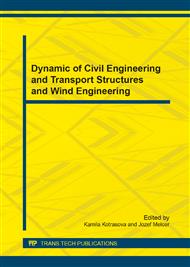[1]
G. K. Batchelor, An introduction to fluid dynamics. Cambridge University Press; (1967).
Google Scholar
[2]
J. Benčat, D., Papán, Buildings Structure Response Due to Rail-Way Traffic Prediction Model In: ICSV18, 18th International Congres on Sound Vibration, 10 - 14 July 2011, Rio de Janeiro, Brazil, pp.1-8.
Google Scholar
[3]
J. Habenberger, J. Schwarz, Damping effects of the fluid in cylindrical liquid storage tanks. Earthquake Engineering and Structural Dynamics, (2005).
Google Scholar
[4]
N. Jendželovský, J. Sumec, Stress-strain fields of the reinforced water tower under seismic loads. In: 9th international scientific conference VSU' 2009, 4 - 5 June, 2009, Sofia, Bulgaria, Vol. 1. Sofia. L. Karavelov civil engineering higher school, 2009. p. I76-I-80.
Google Scholar
[5]
E. Kock, L. Olson, Fluid-structure interaction analysis by the finite element method-a variational approach. International Journal for Numerical Methods in Engineering, Vol. 31, Issue 3, pp.463-491, March 1991, John Wiley & Sons, Ltd.
DOI: 10.1002/nme.1620310305
Google Scholar
[6]
J. Králik, Dynamic analysis of soil-fluid-tank interaction due to earthquake even. In: Dynamika tuhých a deformovatelných těles 2012, sborník přednášek z 10. mezinárodní conference, 10. - 12. října 2012, Ústí n. Labem, Česká republika.
Google Scholar
[7]
J. Melcer, Experimental testing of a bridge. Applied Mechanics and Materials, Volume 486, 2014, Pages 333-340.
Google Scholar
[8]
H. Lamb, Hydrodynamics. 6th ed New York, Dover Publications; (1945).
Google Scholar
[9]
V. Michalcová, S. Kuznětsov, S. Pospíšil, Models of load on buldings from the effects of the flow field, Transactions of the VŠB – Technical University of Ostrava, Civil Engineering Series. Vol. 13, Issue 2, p.91.
DOI: 10.2478/tvsb-2013-0014
Google Scholar
[10]
C. Nitikitpaiboon, K. J. Bathe, An arbitrary Lagrangian-Eulerian velocity potential formulation for fluid-structure interaction. Computers & Structures, 1993. Vol. 47, No. 4/5, p.871–891, Great Britain.
DOI: 10.1016/0045-7949(93)90364-j
Google Scholar
[11]
L. G. Olson, K. J. Bathe, Analysis of fluid-structure interactions. A direct symmetric coupled formulation based on the fluid velocity potential. Computers & Structures, 1985, Vol. 21, No. 1/2, p.21–32. U.S. A.
DOI: 10.1016/0045-7949(85)90226-3
Google Scholar
[12]
EN 1998-4: 2006 Eurocode 8. Design of structures for earthquake resistance. Part 4: Silos, tanks and pipelines, CEN, Brussels, (2006).
DOI: 10.3403/30047498u
Google Scholar
[13]
Theory and Modeling Guide, Volume I: ADINA. December, (2012).
Google Scholar


